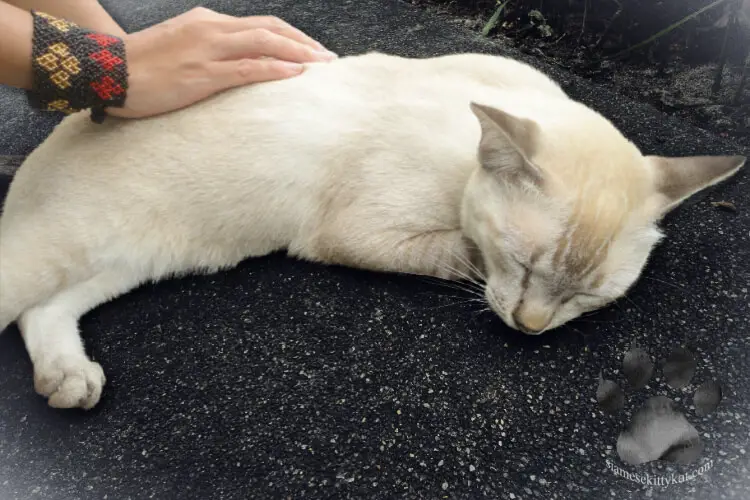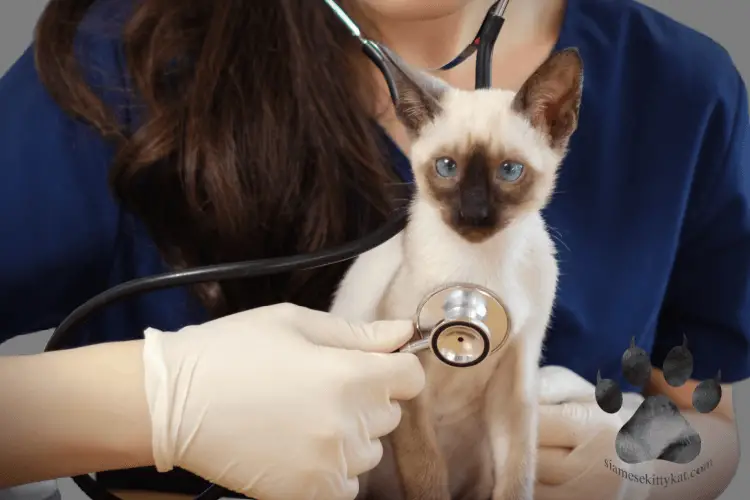Common Siamese cat skin problems are usually related to their hair. Their luxurious coats come with a price. While Siamese cats have many standout features, these same features can also make them more vulnerable.
Siamese cats are more prone to certain types of skin conditions. Some of these conditions are treatable if you know what signs to look for and when to seek help from your vet.
Let’s take a look at some common Siamese cat skin problems and how you can treat them:
Are Siamese Cats Prone to Skin Problems?
Most of the time, yes. Siamese cats are prone to skin problems because they have very thin fur. They also tend to be more sensitive and reactive than other breeds.
Siamese cats are susceptible to skin problems such as:
1. Blastomycosis
Blastomycosis is a fungal infection that can affect many animals, including Siamese cats. A fungus called Blastomyces dermatitidis, found in soil, causes the infection.
The fungus can enter a cat’s body through the skin, eyes, or lungs. It can cause various symptoms, including coughing, difficulty breathing, and weight loss.
The disease can be challenging to diagnose. The symptoms can be like other respiratory infections.
2. Cryptococcosis
Siamese cats are especially susceptible to a fungal infection known as Cryptococcosis. The Cryptococcus neoformans, found in soil and bird droppings, cause this disease.
Infection usually occurs when a cat inhales the fungus. It can cause various symptoms, including pneumonia, weight loss, lethargy, and difficulty breathing. The disease can be fatal if left untreated. Treatment involves the administration of antifungal medications.
Siamese cats are at a higher risk for Cryptococcosis than other breeds. This is according to a study of 155 feline cases in Australia from 1981 to 2001 (O’Brien et al., 2004). The median age of affected cats in the study was 6 years old, with most cases occurring in cats between 2 and 3 years old.
3. Lyme disease
Lyme disease is a rare but serious condition affecting Siamese cats. Ticks transmit this bacterial infection. Symptoms include fever, lameness, joint pain, and swollen lymph nodes. It can cause kidney and heart problems if left untreated.
If your Siamese cat spends time outdoors, be sure to check them for ticks on a regular basis.
If you find a tick on your cat, don’t panic! Grab a pair of tweezers and remove it immediately. Grasp the tick near its head and pull it off gently. It may take a minute or two to remove the tick. Be careful not to leave any part of the tick stuck in the cat’s fur, as this can lead to an infection.
After you pull out the tick, dab a little antibiotic ointment on the spot. A small bump may appear where the tick was. This is normal, but keep an eye out for any redness or irritation.
I have two Siamese cats named Batman and Robyn. They’re indoor cats, but sometimes they sneak out when I’m not looking. I worry about them when they’re outdoors because I know there are ticks in our area that can make cats very sick.
That’s why I always check them for ticks whenever they come back inside after spending time outside. I start by looking at their heads and faces, since that’s where ticks are most likely to attach themselves. I part their fur and look closely for any small, dark dots that could be a tick.
If I find a tick, I carefully remove it with tweezers. I make sure to get the entire tick, including the head. Then I disinfected the area where the tick was.
I know it’s a bother to do this every time Batman and Robyn go outside, but it’s worth knowing that they’re safe from ticks. And who knows, maybe someday they’ll learn their lesson and stay indoors where it’s safe!
4. Allergies

Siamese cats are susceptible to allergies, like any other cat. The most common allergies are flea allergies and food allergies. Siamese cats can also be allergic to other things, such as dust, pollen, and even certain fabrics.
If your Siamese cat is showing an allergic reaction, it’s essential to take them to the vet. They can determine the cause and recommend the best course of treatment.
If certain foods trigger the allergies, your vet may recommend a hypoallergenic diet. Once they have identified the problem, your vet can help you develop a feeding plan. This can include special diets designed to reduce the likelihood of allergic reactions.
My Siamese cat, Robyn, has been having a skin problem lately. It started with him scratching himself more than usual. I thought he had gotten into something outside that was bothering him, but then I noticed that his skin was turning red and inflamed.
I took him to the vet, and they did some tests. Turns out, Robyn has an allergy to something in her food. We’re not exactly sure what it is. Still, we’re working on eliminating different things from her diet until we find the culprit. In the meantime, she’s on a special diet and some medication to help with the itching and inflammation.
5. Ringworm
Siamese cats are susceptible to ringworm. This is a fungal infection that causes baldness and scaly skin patches. Ringworm is contagious and can be passed to humans and between cats.
Ringworm is usually treated with oral antifungal medication coupled with an antifungal shampoo. The fungal spores can remain in your house for months. Thus, you should disinfect or replace items such as grooming tools and bedding.
6. Cat bite abscess
Siamese cats are prone to developing abscesses after being bitten by another cat. The abscesses can occur anywhere on the body, but are mostly found on the head or neck.
If your Siamese cat has been bitten, watch for any signs of an abscess, such as swelling, redness, or heat.
7. Skin growths
Siamese cats are prone to developing lumps, especially as they age. These lumps can be harmless, but they can also be cancerous.
If you notice a lump in your Siamese cat, you must take them to the vet for evaluation. The vet will determine whether the lump is harmless or cancerous. If it is cancerous, your vet will develop a treatment plan to help your cat fight the disease.
Early skin cancer treatment gives your cat the best chance for a successful recovery. You can also help prevent skin cancer by using high-factor sunscreens made for cats.
What Does Dermatitis Look Like on a Cat?
Dermatitis on a cat can present itself in a few different ways. The most common symptom is excessive itching. This can lead to hair loss, open sores, and secondary infections.
You may also see scaly patches of skin, redness, and inflammation. In severe cases, the skin can become thickened and leathery.
Several types of dermatitis can affect Siamese cats. The most common type is allergic dermatitis. This results from an allergy to something in the environment, such as pollen or dust.
Other types include contact dermatitis. This results from having contact with an irritant such as a cleaning product or pesticide. Atopic dermatitis is another type of dermatitis. It is an overreaction of the immune system to environmental allergens.
Treatment for dermatitis depends on the type and severity of the condition. This may include topical steroids, antibiotics, and antihistamines.
How Can I Treat My Cat’s Skin Problems?

It’s essential to diagnose and treat cat skin problems early on. Untreated, some of these conditions can become chronic. This may lead to long-term health issues for your kitty.
The environment they live in, what they eat, stress, genetics, and even grooming can all impact your cat’s skin. It’s good to keep them cool in the summer heat and warm in the cold winter months. You can also do a few things at home to prevent your feline friend from developing these conditions.
Proper nutrition for healthy skin and fur
There are a few nutrients that can help keep your cat’s skin healthy.
Great nutrition is helpful if your cat has a skin problem. It’s even more critical if you want to prevent one in the first place.
Examine your cat’s diet
One cause of skin issues could be diet deficiency. Knowing what to look for can help you catch a problem before it worsens.
Grooming is the key
As with any other cat, you must clean your Siamese coat on a regular basis to avoid skin issues. You can brush your Siamese cat’s coat every few weeks. This will help prevent problems like hairballs and help your cat shed its coat properly.
You should also make sure to check your Siamese cat’s ears on a regular basis. You can do this by using a cotton swab to rub the inside of the ear. This will allow you to check your cat’s ears for mites or gunk that may have built up there.
Cats groom themselves because they like to keep themselves clean. But if they groom too much, they can cause skin problems. If your cat licks the same spot on its body on repeat, it may cause an itchiness or discomfort. It’s essential to treat the spot, so they don’t keep licking it and make it worse.
Licking is a sign of stress in cats. If they do this to the point of hair loss or causing rashes, this shows that their home environment isn’t ideal for them. Cats that lick the same spot also have lower self-esteem.
Cats are sensitive beings. If you notice them licking too much, you should look for ways to make them feel comfortable.
Siamese cats can be healthy and happy, but if they have a skin problem, it can be very difficult to identify the cause. This breed is prone to skin sensitivities and allergies. They also tend to get used to various textures and environments. They are often the victims of molds and pollen, which can trigger skin problems.
Skin problems in this breed are often overlooked. Thus, you may want to take them to the vet to get diagnosed and receive treatment.
Thanks for reading!
We gathered all the health tips tailored towards maintaining your Siamese cat’s optimal well-being. Check it out here: Siamese Cat Health: A Complete Guide
